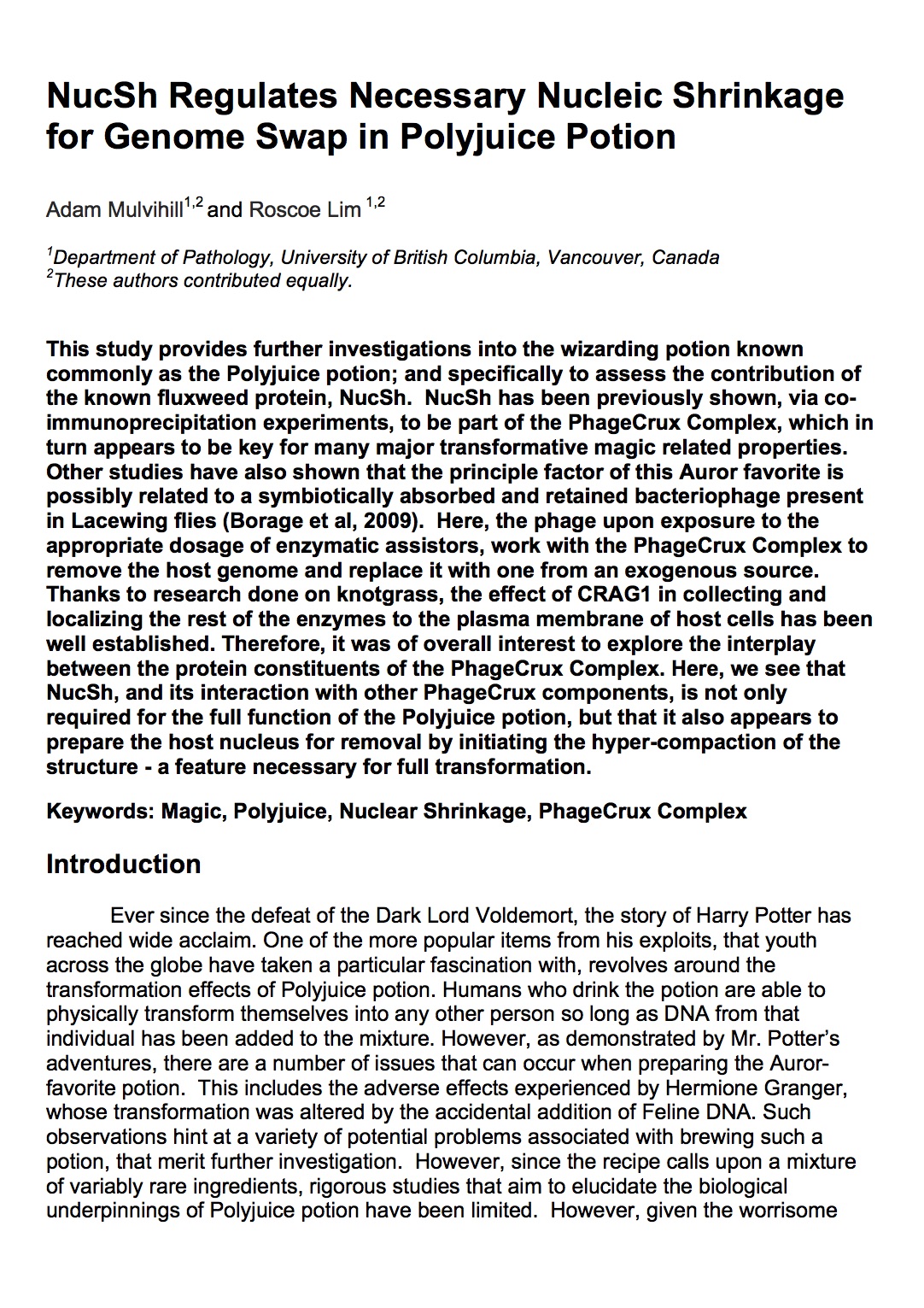NucSh REGULATES NECESSARY NUCLEIC SHRINKAGE FOR GENOME SWAP IN POLYJUICE POTION
Annals of Praetachoral Mechanics (2016). Vol 2. Advanced online publication. download pdf
ABSTRACT
This study provides further investigations into the wizarding potion known commonly as the Polyjuice potion; and specifically to assess the contribution of the known fluxweed protein, NucSh. NucSh has been previously shown, via co-immunoprecipitation experiments, to be part of the PhageCrux Complex, which in turn appears to be key for many major transformative magic related properties. Other studies have also shown that the principle factor of this Auror favorite is possibly related to a symbiotically absorbed and retained bacteriophage present in Lacewing flies (Borage et al, 2009). Here, the phage upon exposure to the appropriate dosage of enzymatic assistors, work with the PhageCrux Complex to remove the host genome and replace it with one from an exogenous source. Thanks to research done on knotgrass, the effect of CRAG1 in collecting and localizing the rest of the enzymes to the plasma membrane of host cells has been well established. Therefore, it was of overall interest to explore the interplay between the protein constituents of the PhageCrux Complex. Here, we see that NucSh, and its interaction with other PhageCrux components, is not only required for the full function of the Polyjuice potion, but that it also appears to prepare the host nucleus for removal by initiating the hyper-compaction of the structure – a feature necessary for full transformation.
Keywords: Magic, Polyjuice, Nuclear Shrinkage, PhageCrux Complex
Introduction
Ever since the defeat of the Dark Lord Voldemort, the story of Harry Potter has reached wide acclaim. One of the more popular items from his exploits, that youth across the globe have taken a particular fascination with, revolves around the transformation effects of Polyjuice potion. Humans who drink the potion are able to physically transform themselves into any other person so long as DNA from that individual has been added to the mixture. However, as demonstrated by Mr. Potter’s adventures, there are a number of issues that can occur when preparing the Auror-favorite potion. This includes the adverse effects experienced by Hermione Granger, whose transformation was altered by the accidental addition of Feline DNA. Such observations hint at a variety of potential problems associated with brewing such a potion, that merit further investigation. However, since the recipe calls upon a mixture of variably rare ingredients, rigorous studies that aim to elucidate the biological underpinnings of Polyjuice potion have been limited. However, given the worrisome interest in the potion by the youth, and general fear of misuse, there is now a major push for biologically classifying its ingredients as well as characterizing the potion’s biochemical effects.
One ingredient, knotgrass, is actually readily available as a commercially sold product throughout the wizarding world, and has been identified and characterized previously. Through extensive analyses, it was shown that it contains a protein, CRAG1, which acts as a recruiter and nucleation point for a complex of proteins. Their results utilizing a CRAG1 negative variant of the plant, showed no transformations of host into donor, leading them to an investigation of its protein to protein interactions with other potential constituents of the potion. After performing co-immunoprecipitation assays (Bourne et al., 2010), data suggested the presence of a complex (PhageCrux complex) that was primarily composed of three proteins, each of which appeared to be derived from three different ingredients.
In this paper, we have assessed the role of fluxweed and its respective PhageCrux protein, NucSh. Note that previously, research has been difficult given the challenges in harvesting fluxweed specimens (its main habitat involves a close association with Whomping Willows, and therefore present a unique field challenge). However, given the dire circumstances and feared epidemic proportions of illicit Polyjuice usage by the youth population, the Wizengamot has decreed an aggressive retrieval of the plant for scientific purposes. This has led to preliminary studies, such as characterizations by Slughorn et al (2013), who provided the genetic and peptide sequence of the 98 kDa gene product.
We used mammalian model systems to observe NucSh, and its function in the PhageCrux Complex. First, we performed experiments where fluxweed was removed and the potion and then monitored for effect: this is analogous to previous experiments done with the removal of knotgrass in mice studies (Borage et al, 2013). We chose a transformation parameter that was easily visualized on the mice (fur color change), to measure relative effectiveness of the potion. In our fluxweedneg experiments, mice transformed to a maximal 50%, with random expression patterning. This, we attributed to the removal of NucSh from the PhageCrux complex, leading to further exploration of its role. Considering the removal of CRAG1 lead to a complete lack of transformation, we took the uniform rate of NucShneg partial effects to indicate a functional issue during the actual process of transformation.
To assess the cause, we performed analyses of the transfer of genetic material via sequential sectioning and differential DNA staining with DAPI (blue) and Acradine Orange (orange) to indicate which genome was present in each time frame. Then, to assess the methods by which NucSh reaches the nucleus, a GFP-tagged gene construct version of NucSh was used in endogenous fluxweed combined with one of the following transgenic Mouse lines: RFP-tubulin, YFP-actin, and EBFP-cytokeratin. Using Confocal microscopy, potential localization of GFP-NucSh was observed.
Results
Transformation
DBA/2-Elite mice were treated with properly brewed Polyjuice potion carrying DNA from male C57BL/6N. The non-agouti, dilute brown fur colour of the DBA/2-Elite became black, a hallmark phenotype of the C57BL/6N mice. The success of this transformation confirms that the Polyjuice potion works not in only in humans but in mice as well and also provides a working in vivo model for Polyjuice potion experiments (Fig. 1).
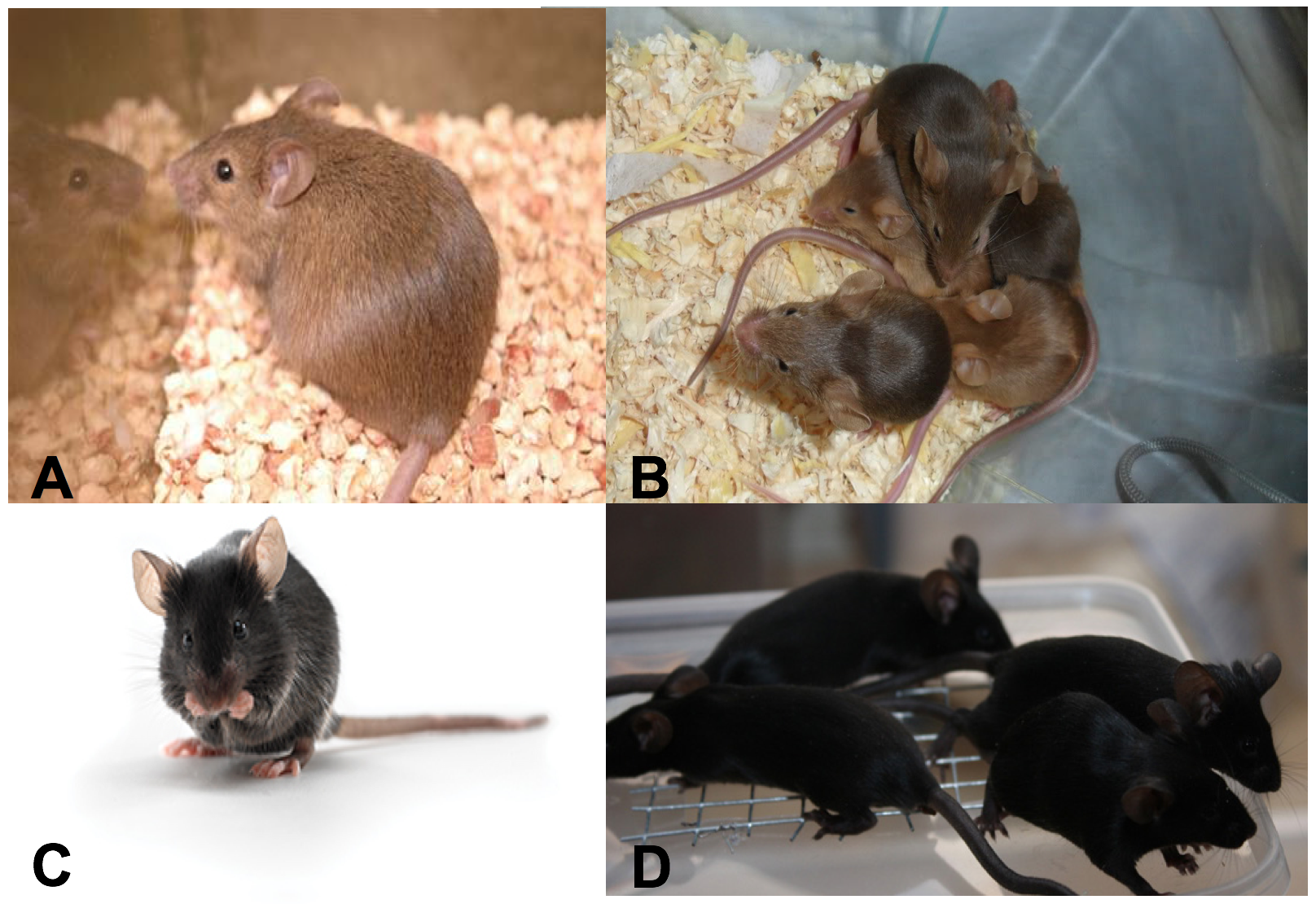
(CLICK IMAGE TO ENLARGE) Figure 1. Male DBA/2-Elite with non-agouti, dilute brown fur (A,B). Male C57BL/6N with black fur (C). Litter of DBA/2-Elite mice treated with Poly Juice potion carrying C57BL/6N DNA transformed (D).
.
Polyjuice potion carrying C57BL/6N DNA was brewed without fluxweed (PJP-NucSh) and treated in DBA/2-Elite mice. This experiment allows assessment of the importance of the NucSh protein. The mice exhibited a mix phenotype between DBA/2-Elite and C57BL/6N 120 seconds after application (Fig. 2). The NucSh protein is therefore necessary for the efficacy of the potion and complete transformation of the host.
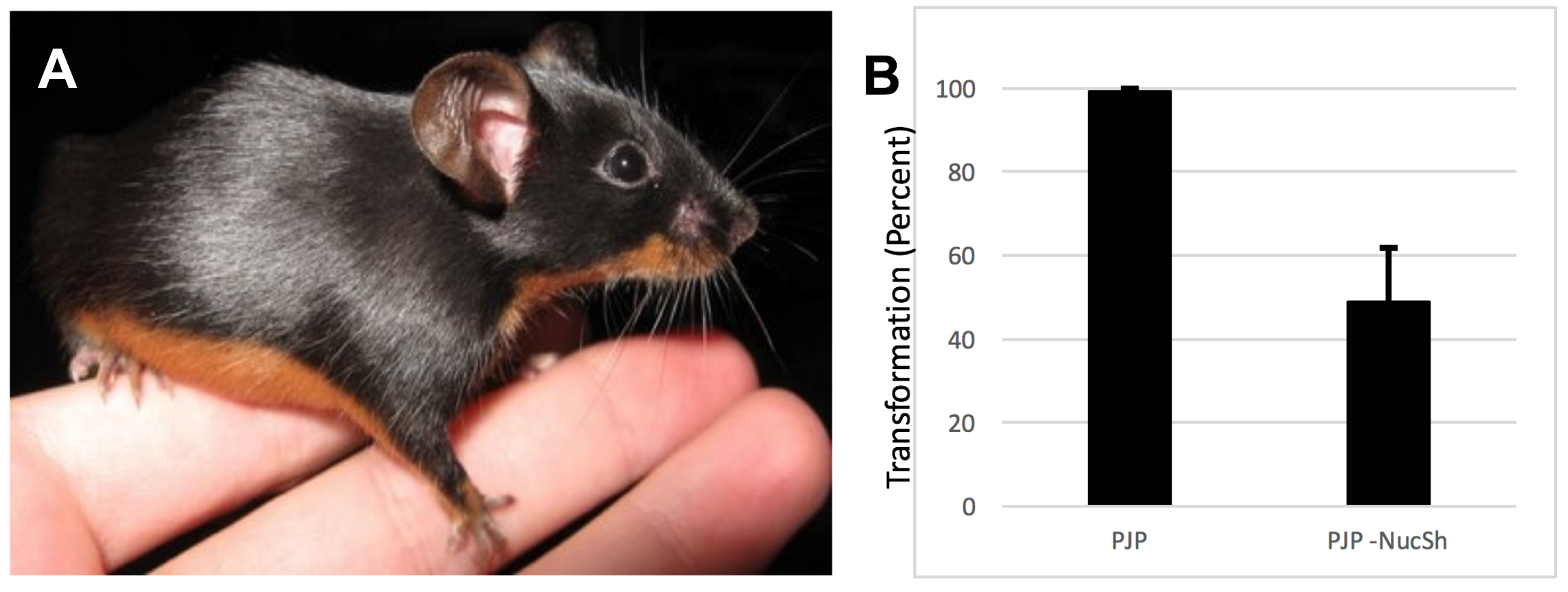
(CLICK IMAGE TO ENLARGE) Figure 2. Male DBA/2-Elite treated with PJP-NucSh (A). PJP treated mice had a 99 (±0.86)% transformation while PJP-NucSh treated mice had 48 (±12)% transformation (B). PJP and PJP-NucSh each had sample size of 8.
.
To better understand the role of NucSh protein, C57BL/6N epithelial cells were stained with DAPI while DBA/2-Elite epithelial cells were stained with Acridine Orange. The C57BL/6N + DAPI hair cells were then used to brew Polyjuice potion with fluxweed (PJP.DAPI) and one without (PJP.DAPI-NucSh).
Shrinking of the DBA/2-Elite epithelial cell nucleus was observed over time when treated with PJP.DAPI. As the DBA/2-Elite nucleus shrinks, C57BL/6N nucleus begins to enter the cell and act as the functioning nucleus. However, in DBA/2-Elite hair cells treated with PJP.DAPI-NucSh nucleus shrinkage was not observed as the C57BL/6N nucleus enters (Fig. 3). The presence of two full sized nuclei caused the cell to exhibit no cellular functional change other than the presence of two nuclei. It can be inferred the NucSh protein plays a role in donor nucleus shrinkage, key to brewing a successful, fully transformative Polyjuice potion.

(CLICK IMAGE TO ENLARGE) Figure 3. A: Epithelial cells treated with PJP-NucSh after 5 seconds (i) and 120 seconds (ii). B: Epithelial cells treated with PJP after 5 seconds (i) and 120 seconds (ii).
.
To gain more information on this observation, it was necessary to perform an isolation of the protein for sequencing. Previous data confirms an isoelectric point of 6 with a weight of 98 kDa (Fig. 4). Based on this, isolation of the protein from a 2D gel was possible. After sequencing at DiaGen Alley Bioinformatics, we outsourced the creation of YFP-NucSh construct and, finally, performed a transformation of Fluxweed with the construct (not shown).
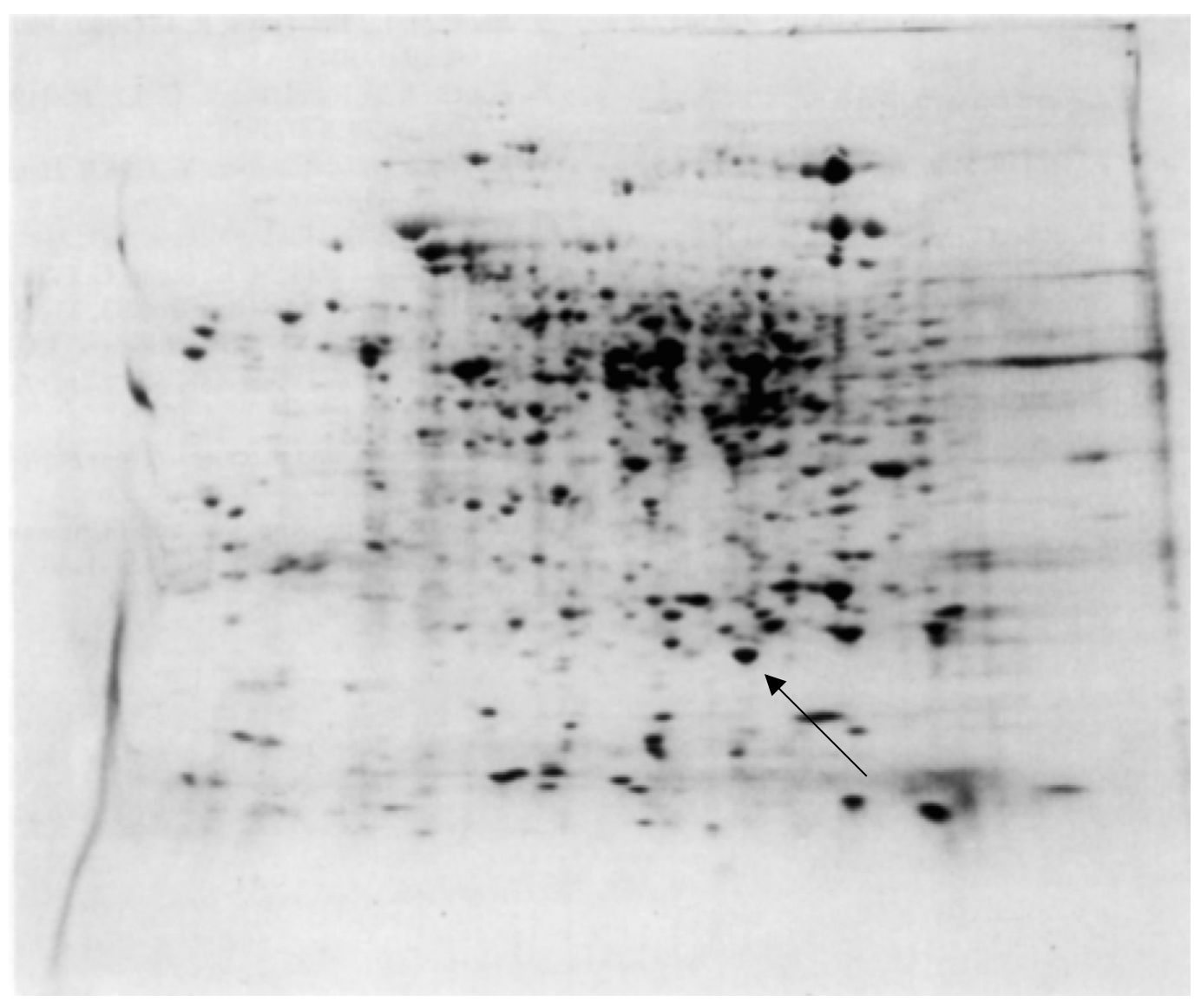
(CLICK IMAGE TO ENLARGE) Figure 4. Two-dimensional electrophoresis of a sample representing 200 µg of proteins from 50 buds of fluxweed. The direction of isoelectric focusing is from right to left. The second dimension SDS-electrophoresisis from top to bottom.
.
Upon imaging, transgenic mouse epithelial cells showed co-localization of YFP-NucSh along the plasma membrane, specifically in Microtubule domains. RFP-Tubulin and YFP-NucSh appear to have similar points of contact with cellular boundaries, whereas other cytoskeletal elements (actin, cytokeratin) rarely presented points of contact (Fig. 5).
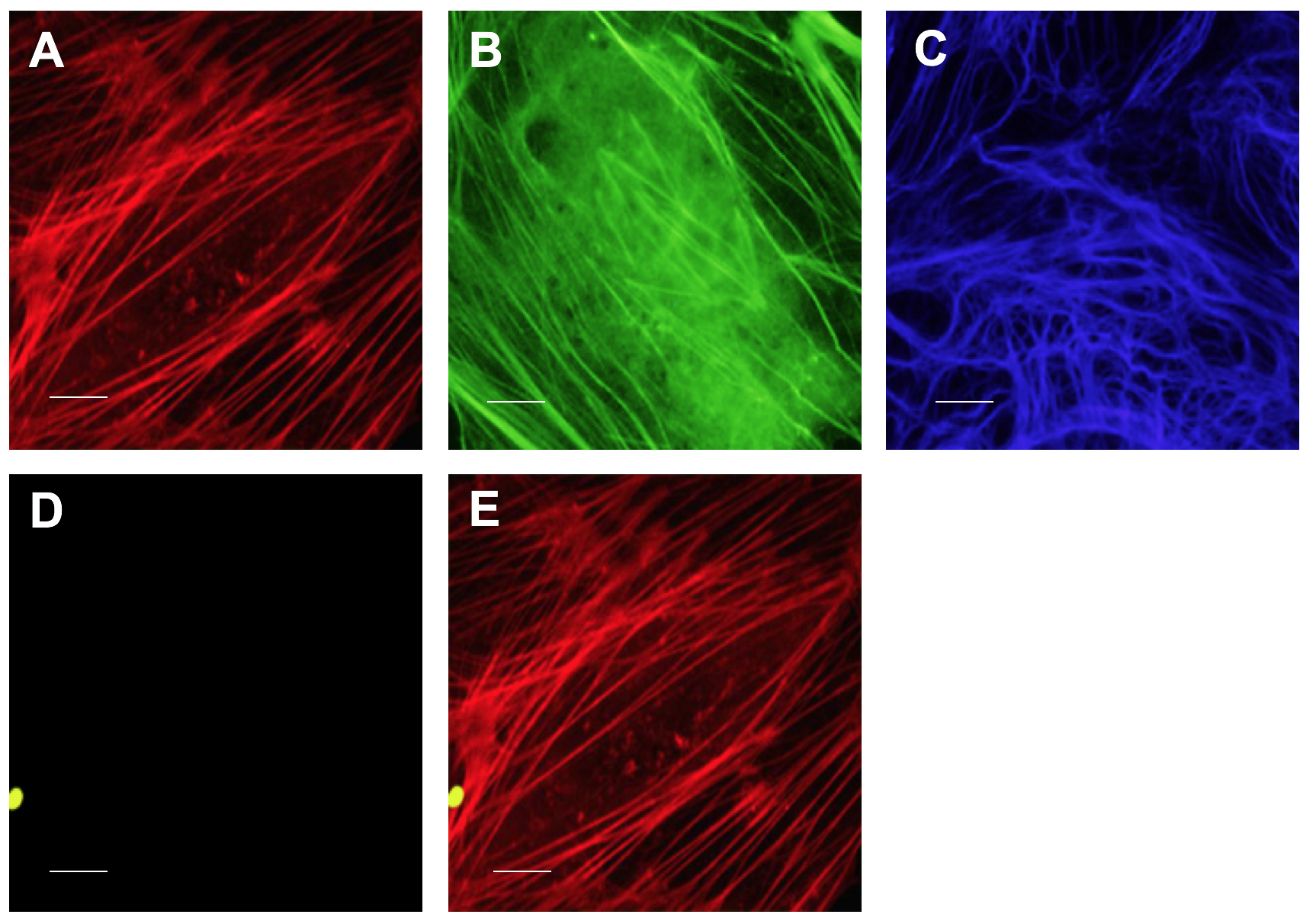
(CLICK IMAGE TO ENLARGE) Figure 5. Localization of NucSh in epithelial cells. RFP-tubulin (A). GFP-Actin (B). EBFP-cytokeratin (C). YFP-NucSh (D). Merge RFP-tubulin and YFP-NucSh (E). Standard magnification was a 100X N.A. 1.45 lens with standard coverslips. The camera was a high speed 512 X 512 EM Andor. Scale bar is equivalent to 2 µm.
.
Methods
DAPI and Acridine Orange staining
Cells were cultured on coverslip plates and incubated with appropriate stain. Epithelial Host tissue was incubated in DAPI prior to exposure to Polyjuice Potion, whereas Donor tissue was incubated in Acridine Orange prior to addition to the recipe. 1mL DAPI solution (1:5000 in PBS) to stain C57BL/6N mice cells and 1mL Acridine Orange solution (1:5000 in PBS) to stain DBA/2-Elite mice. The cells were analyzed using an epifluorescence microscope.
Animals
Male DBA/2 Elite mice and male C57BL/6N mice aged 6 – 8 weeks, weighing 20 – 22 g, were obtained from Charles River Laboratories. All animals were housed at constant room temperature of 24ºC and had access to tap water and pelleted chow.
Experiments were performed during the light phase of a continuous 12-h light/dark cycle with the lights on from 0800h to 2000h. The present experiments were approved by the Hogwarts Animal Magic and Science Experimental Ethics Committee.
Polyjuice Potion
The brewing was conducted as described in Moste Potente Potions. Polyjuice potion without NucSh protein skipped the addition of fluxweed and carried on to the next step.
NucSh Isolation and Fluorescent Construct
In order to create a fluorescent construct, NucSh was isolated via SDS-Page of fluxweed endogenous proteins. Proteins from 50 buds of fluxweed were extracted by grinding the buds in nitrogen and transferring the powder in extraction buffer (50mM Tris-HCL, pH 7.4, at 4 degrees C, .25M sodium ascorbate) containing insoluble PVP. After centrifugation, proteins were precipitated with Ammonium sulfate (90% saturation) at pH 7.9 and centrifuged. The pellet was resuspended in solubilization buffer consisting of .5% SDS, 9.5 M urea, 5% -mercaptoethanol, and 2% Ampholines and dialyzed overnight against 250 vol of the same buffer. A sample representing 200 ug of proteins was processed by two-dimensional electrophoresis, from which we isolated our protein based on size and pH. Lastly, samples were sent for sequencing analysis to DiaGen Alley Bioinformatics. Based on that data, a YFP-NucSh construct was designed with the tag located near the N-terminus, away from a functional exon near the C-terminus, as indicated by sequencing data.
Tissue Preparation
We generated transgenic male DBA/2-Elite mice in which GFP-NucSh and either RFP-tubulin, YFP-actin, or EBFP-cytokeratin were being expressed. For Confocal preparation, epithelial cells were harvested from one week old mice, immediately transferred to 39 degree incubation liquid, and mounted for microscopy.
Confocal Microscopy
Olympus IX70 Flourescence and TIRF microscope is for use with coverslip bottom dishes, chambers or coverslips mounted on slides. There are lasers at various nanometer excitations for a variety of probes. Standard magnification was a 100X N.A. 1.45 lens with standard coverslips. The camera was a high speed 512 X 512 EM Andor. An external filter wheel changes fluorescent emission wavelengths rapidly.
Image Processing
All image processing done with ImageJ to adjust for bleaching, contrast, and size and to produce merged images of co-localizations.
Discussion
Before now, Polyjuice potion has been a relatively uninvestigated biochemical staple of the Wizarding World. Based on previous incidents of misuse, it has been shown to cause aberrant changes to a species-specific malady when interspecies donor DNA is mistakenly added. Consequently, the efficacy of the potion must be transferrable amongst species. However, the mechanism by which this occurs, and the role that the fluxweed protein NucSh has in the process, was still largely unknown.
Intraspecies effects, no matter the species, remain robust and stable (Fig. 1). Since the phenotypic effects of Polyjuice potion are well known, we were able to monitor transformations via a simple color change to sufficiently indicate complete genetic transfer.
A standardized screen of the removal of NucSh from the Polyjuice recipe (Fig. 2A) yielded non-standard results. All mice supplied with the complete form of the potion underwent standardized transformation, brown to black. The removal of NucSh from the recipe appears to have caused a mixed effect. On all rats, in no observable pattern, a 50% transformation seems to have occurred (Fig. 2B). All cell types and anatomical regions appear to have a uniform opportunity to either transform or not.
It is therefore likely that incomplete dominance, a genetic model seen often in individuals with a single genome, heterozygous for a dominance-lacking trait, may mirror this process most closely. In such a case, every cell has an equally probable chance to express a phenotype that is coded by its present genes. More clearly, there is no dominant expression pathway. For these mice to have transformed at all means that a second nuclei, or a second set of genetic information, has been transferred to the host but has become subject to competitive expression. The only means by which this seems possible is the cohabitation of a single cell by two nuclei.
To test this hypothesis, nuclei of the Host and Donor were differentially stained (Fig. 3). Host DNA appears blue (DAPI), while Donor DNA appears orange (Acridine Orange). During normal Polyjuice effect, the Host nucleus shrinks over time. Once at its final size, the Donor nucleus is inserted via the Bacteriophage, and an organized swap of nuclei occurs. Temporarily, the Host DNA is held within the Bacteriophage, while the Donor DNA enlarges and begins expression of its genome.
However, in the recipe lacking NucSh, the potion has a consequentially profound effect: binucleation. The two nuclei cohabitate the cell as a result of a singularly lacking event. With no shrinkage of the Host nucleus, the Bacteriophage is unable to contain it and the cell is left to devise which genome to express. This leads us to believe that the cellular response for what to do during binucleation is encoded in the DNA of one of the two individuals.
Our hypothesis is that it may even be tied to Sex Chromosome inactivation. X chromosomes have an encoded sequence that shuts down the other for transcriptional purposes in females. These males may have differential sequence homology in their X chromosomes, normally functional for inactivation in women only, that lead to preferential activation of genome silencing machinery, depending on cellular context. With the presence of two X Chromosomes, due to binucleation of two males (XY/XY), the appropriate admixture of genetic information is present to induce such a process. More investigation into the Sex-Linked regulation of bi-genome expression is a major focus of current research.
With such a stark cellular effect, it was surprising that the role of NucSh was still mostly unclear. The magical subtext related to the shrinkage of a nucleus and all of its components seems somewhat otherworldly. Simply, we wondered, if the cell even had the machinery to perform such a task, or if the effect was simply the result of Wizardry. Considering the relatively massive amount of space between localization of the Bacteriophage at the plasma membrane and a regularly distributed nucleus, the machinery used for order and structure that could be capable of such a task, the cytoskeleton, was the ideal candidate.
Using Confocal microscopy, GFP-NucSh was shown co-localized with each of the majorly involved cytoskeletal elements available to us (Fig. 5). Based on the fluorescence, the localization of NucSh to the plasma membrane at a single point was clear. However, what it co-localized with was more difficult to assess. The point of contact was seemingly in Microtubule domains, shown in the merged image with RFP/GFP, but due to only one point of contact per cell, it became difficult to assess what could be chance and what would be regulated. It was necessary to look at a large number of images, since only one complex per cell was observed. In every instance, the same result was seen of co-localization with a Microtubule domain, whereas other cytoskeletal elements had minor levels of coexpression, ultimately attributed to random chance.
These images represent the absolute entirety of images acquired and suggest that the single attachment point of the Bacteriophage may also be regulated to Microtubule dense domains at the plasma membrane. Without staining of the nuclei and further proteomic analysis, it is hard to tell the ways in which NucSh regulates the actual shrinkage of the Host genome. We hypothesize a pulley, of sorts, where the PhageCrux Complex, containing functional NucSh, hyper-tightens the nuclear structure via interaction with the inner-lamellar cytoskeletal elements. Host cytoskeletal mutants (knockdown) or chemically inducible variants could be a potentially fruitful area of future research for analyzing the exact regulation of Nuclear Shrinkage.
References
1. Criver.com,. (2014). C57 Mice | Charles River. Retrieved 13 November 2014, from http://www.criver.com/products- services/basic-research/find-a-model/c57bl-6n-mouse
2. Fancymicebreeders.com,. (2014). Fancy Mice Breeders • View topic – FOR SALE-Mice- Kent. Retrieved 13 November 2014, from http://www.fancymicebreeders.com/phpBB3/viewtopic.php?f=32&t=11776
3. Harry Potter Wiki,. (2014). Polyjuice Potion. Retrieved 13 November 2014, from http://harrypotter.wikia.com/wiki/Polyjuice_Potion
4. Hiiret.fi,. (2014). Hiiret.fi – Breeding. Retrieved 13 November 2014, from http://hiiret.fi/eng/breeding/?pg=4&sub=3&ala=2
5. Lifetechnologies.com,. (2014). CellLight® Actin-RFP, BacMam 2.0 – Life Technologies. Retrieved 13 November 2014, from http://www.lifetechnologies.com/order/catalog/product/C10583
6. Lim, H., Asharani, P., & Hande, M. (2012). Enhanced Genotoxicity of Silver Nanoparticles in DNA Repair Deficient Mammalian Cells. Frontiers In Genetics, 3. doi:10.3389/fgene.2012.00104
7. Microscopyu.com,. (2014). Nikon MicroscopyU | Fluorescence Microscopy | Filter Combinations (YFP HYQ) | Albino Swiss Mouse Embryonic Cell Actin. Retrieved 13 November 2014, from http://www.microscopyu.com/articles/fluorescence/filtercubes/yfp/yfphyq/actin/yfpactin3t3cells.html
8. Microscopyu.com,. (2014). Nikon MicroscopyU | Fluorescence Microscopy | Filter Combinations (BFP) | Rat Kangaroo Cell Intermediate Filaments. Retrieved 13 November 2014, from http://www.microscopyu.com/articles/fluorescence/filtercubes/violet/bfp/bfpptk2keratinlarge.html
9. msnbc.com,. (2011). 2011 Weird Science Awards. Retrieved 13 November 2014, from http://www.nbcnews.com/id/40858197/ns/technology_and_science-science/t/weird-science-awards/#.VGRFp_nF_Z0
10. Pottermore.wikia.com,. (2014). Pottermore Wiki. Retrieved 13 November 2014, from http://pottermore.wikia.com/wiki/Pottermore_Wiki
11. Sciencedirect.com,. (2014). Method for extraction of proteins from green plant tissues for two-dimensional polyacrylamide gel electrophoresis. Retrieved 14 November 2014, from http://www.sciencedirect.com/science/article/pii/0003269785900041#
12. Sites.google.com,. (2014). previousmice – jinglesmousery. Retrieved 13 November 2014, from https://sites.google.com/site/jinglesmousery/previousmice
